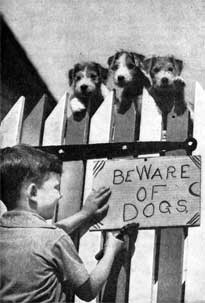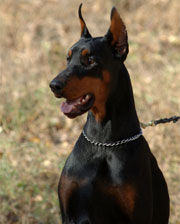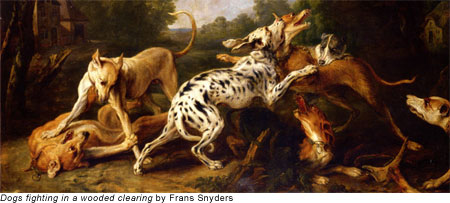 Beware of Dogs: After thousands of years of domestication and breeding most dogs are safe, even protective of humans. But their defensive and aggressive natures have not been completely eliminated. It must be remembered that dogs are descended from wolves. They are superpredators and can be provoked into an attack for countless reasons. A little child may playfully pull its tail or a cruel owner may train the dog to fight. Regardless of the reason, if a dog feels threatened, or hungry, or has been trained towards aggression they can be a very real threat for anyone. For their part, humans should always be aware of the dog's innate canine nature. Beware of Dogs: After thousands of years of domestication and breeding most dogs are safe, even protective of humans. But their defensive and aggressive natures have not been completely eliminated. It must be remembered that dogs are descended from wolves. They are superpredators and can be provoked into an attack for countless reasons. A little child may playfully pull its tail or a cruel owner may train the dog to fight. Regardless of the reason, if a dog feels threatened, or hungry, or has been trained towards aggression they can be a very real threat for anyone. For their part, humans should always be aware of the dog's innate canine nature.
Record Numbers: There is much debate as to whether dog attacks are the result of poor training, or simply the real nature of the canine rearing its head. We do know that dog attacks have increased over the past century. There are about 4.7 million non-fatal dog bites per year, with about 350,000 treated in medical centers (333,700 in 1994). And sadly, most people medically treated for dog bites are children between 5 and 9.
Rabies!: Most of these do not result in terribly serious injuries. It is a common misconception to believe that dogs are the primary cause of rabies. But the truth is, most cases are the result of attacks by wild animals, specifically raccoons, skunks, and bats. Some cases from dogs still happen, but most dogs in the U.S. have been vaccinated. If attacked, however, by either a strange dog or a dog that may possibly be infected with rabies, it should be addressed immediately, usually within the first 48 hours, especially for children. If the dog was unprovoked the risk is higher.
Bad Reps: Different dogs, or dog breeds, have different reputations at different times. In the 1970s Doberman Pinchers were considered the most dangerous dogs in the world. But this was not for any factual or scientific reason, but because of a movie –  The Omen. Today, it is the Pit bull with a bad reputation. This reputation is not completely baseless, but needs to be understood properly. The United States Department of Health and Human Services recently did a study investigating fatal dog attacks in the U.S. According to report, Pit bulls were involved in (approximately) 1/3 of Dog Bite Related Fatalities during a 12-year period from 1981 through 1992. This is somewhat horrifying for Pit bull owners but it can be a misleading for several reasons. Firstly, the Pit bull is not a distinct breed, rather it is a term used to describe several different breeds. Secondly, witnesses often stereotypically call aggressive dogs "Pit bulls," thanks to some enduring myths. Those myths, now applied to Pit bulls, were once applied to Dobermans. In fact, they are generally applied to any dog with a bad reputation. The Omen. Today, it is the Pit bull with a bad reputation. This reputation is not completely baseless, but needs to be understood properly. The United States Department of Health and Human Services recently did a study investigating fatal dog attacks in the U.S. According to report, Pit bulls were involved in (approximately) 1/3 of Dog Bite Related Fatalities during a 12-year period from 1981 through 1992. This is somewhat horrifying for Pit bull owners but it can be a misleading for several reasons. Firstly, the Pit bull is not a distinct breed, rather it is a term used to describe several different breeds. Secondly, witnesses often stereotypically call aggressive dogs "Pit bulls," thanks to some enduring myths. Those myths, now applied to Pit bulls, were once applied to Dobermans. In fact, they are generally applied to any dog with a bad reputation.
A Silly Rumor: Some say that Pit bulls often suffer from a swelled brain, which causes dementia and aggression. But the fact is, if any dog’s brain swelled, it would lead not to dementia, but death. In the 1970s the same thing was said about Doberman Pinschers, since, at the time, they were considered the most dangerous dogs. Now that Pit bulls are considered inherently violent, it is being said about them. But the fact is, there is no basis for this nasty rumor.
The Death Penalty: Despite the myths, dog attacks are real. Their increasing frequency has caused legislation to be passed here in the U.S. and throughout the world. The Dangerous Dog Act of 1991 placed restrictions on the Tosa, Dogo Argentino, Fila Brasileiro and Pit Bull Terrier in London. It was passed after several highly publicized dog attacks. The act made it illegal to own any of these dogs without a court exception. In public, these dogs had to be leashed and muzzled. A Pit Bull Terrier named Dempsey was being walked by its owner in London one day when the dog began to gag. The owner quickly removed its muzzle, but when the dog was seen by a police office it was arrested and impounded. After a trial, Dempsey was sentenced to death. Luckily the ruling was overturned after substantial public outcry, but similar legislation has been passed in other countries.
Generally speaking, dogs involved in any (seemingly) unprovoked attack are usually neglected, poorly trained or improperly socialized.
Bad Sports: One particular problem is dog fighting. The "sport" has a long and bloody history in the U.S. and worldwide. It has existed in nearly every society throughout history. Some dogs, like the Pit Bull, were bred specifically for dog fighting. People, especially young men hoping to develop their tough guy reputation, still train dogs in such a manner. These dogs are sometimes starved, abused, or grossly mistreated, and their aggression towards humans is really the result of fear and an almost innate suspicion. In Virginia it is essentially illegal to be involved in dog fighting in any way. Many Pit bull types have never been able to shake their reputation, although those that are well trained and properly socialized are usually friendly dogs, and even gentle and affectionate.

Speak, Doggie, Speak!: When a dog is preparing to attack it does give off some signs, although it is not always possible for human beings to interpret these signs clearly. A dog wagging its tail is usually a sign of excitement but not always. It can very likely be a sign of a dog preparing to defend its territory. Generally dogs attack when they feel threatened, so it is best to avoid behavior that could appear that way. Pulling away their food, surprising a sleeping dog, invading their territory, or approaching a strange dog are all bad ideas. In dog communication, eye contact is usually a sign of aggression, especially when on the same level, as is true with children.
They have been domesticated for centuries and most are perfectly comfortable with humans, but their natural instincts are never completely suppressed, so people should approach dogs with, at least some, caution.
|
